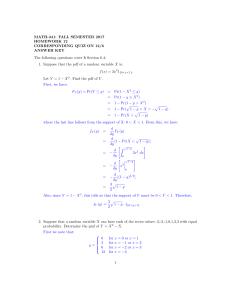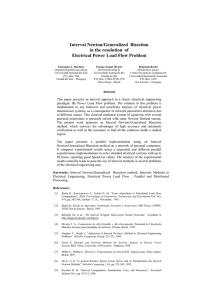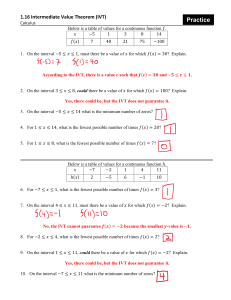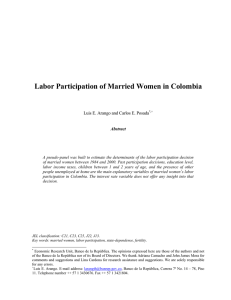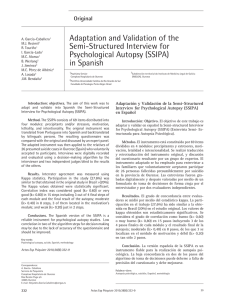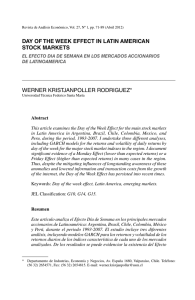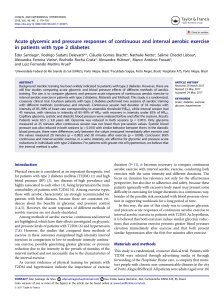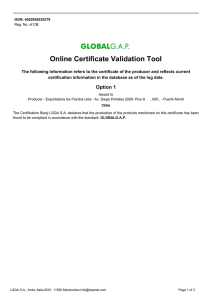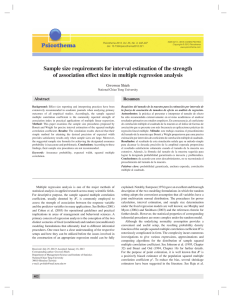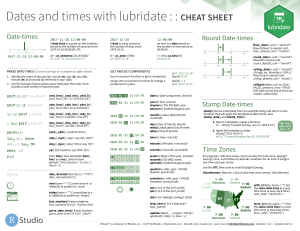Estad´ıstica Some commentaries on confidence intervals of
Anuncio
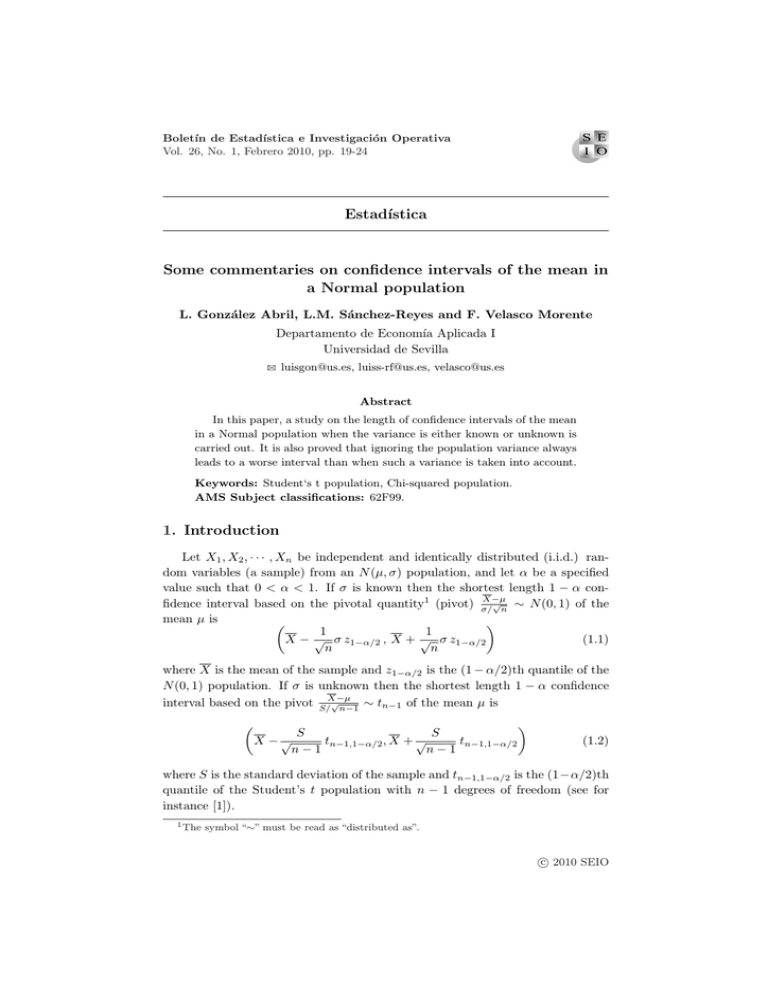
Boletı́n de Estadı́stica e Investigación Operativa Vol. 26, No. 1, Febrero 2010, pp. 19-24 Estadı́stica Some commentaries on confidence intervals of the mean in a Normal population L. González Abril, L.M. Sánchez-Reyes and F. Velasco Morente Departamento de Economı́a Aplicada I Universidad de Sevilla B [email protected], [email protected], [email protected] Abstract In this paper, a study on the length of confidence intervals of the mean in a Normal population when the variance is either known or unknown is carried out. It is also proved that ignoring the population variance always leads to a worse interval than when such a variance is taken into account. Keywords: Student‘s t population, Chi-squared population. AMS Subject classifications: 62F99. 1. Introduction Let X1 , X2 , · · · , Xn be independent and identically distributed (i.i.d.) random variables (a sample) from an N (µ, σ) population, and let α be a specified value such that 0 < α < 1. If σ is known then the shortest length 1 − α conX−µ √ ∼ N (0, 1) of the fidence interval based on the pivotal quantity1 (pivot) σ/ n mean µ is µ ¶ 1 1 X − √ σ z1−α/2 , X + √ σ z1−α/2 (1.1) n n where X is the mean of the sample and z1−α/2 is the (1 − α/2)th quantile of the N (0, 1) population. If σ is unknown then the shortest length 1 − α confidence √ interval based on the pivot S/X−µ ∼ tn−1 of the mean µ is n−1 µ ¶ S S X −√ tn−1,1−α/2 , X + √ tn−1,1−α/2 n−1 n−1 (1.2) where S is the standard deviation of the sample and tn−1,1−α/2 is the (1−α/2)th quantile of the Student’s t population with n − 1 degrees of freedom (see for instance [1]). 1 The symbol “∼” must be read as “distributed as”. c 2010 SEIO ° 20 L. González Abril, L.M. Sánchez-Reyes, F. Velasco Morente Let us consider a toy example: suppose that x1 = 0.95 and x2 = 1.05 is a sample from an N (µ, σ) population and two researchers want to build a 0.90 confidence interval of the unknown parameter µ. The first researcher knows that σ = 1 and therefore, from (1.1), the confidence interval of µ is I1 = (−1.630 , 2.163). But for the second researcher, σ is unknown and therefore, from (1.2), the confidence interval will be I2 = (−0.684 , 1.316). In view of these intervals the following question arises: how can I2 be more accurate (shorter) than I1 when the latter needs less information? The main aim of this paper is to answer this question. 2. Ratio of lengths Intervals (1.1) and (1.2) have the same center (X) although different radii. The length of the interval (1.1) is √2n σ z1−α/2 , which only depends on the size 2 of the sample, whereas the length of the interval (1.2) is √n−1 S tn−1, 1−α/2 , that depends on the sample because S = S(X1 , · · · , Xn ) is a statistic. To compare these two lengths, we are going to study the random ratio between √ them which t √ n S. will be denoted by C = C(X1 , · · · , Xn ), that is, C = n−1,1−α/2 z1−α/2 n−1 σ Let us recall two well-known results (see for instance [1]): i) If X1 , · · · , Xn 2 2 are i.i.d. random variables from an N (µ, σ) population, then nS σ 2 ∼ χn−1 ; and 2r Γ(r+ p ) ii) if Y ∼ χ2p then E[Y r ] = Γ( p ) 2 , where Γ(x) is the gamma function and r 2 and p are positive. Hence, the probability density function (pdf) of C, denoted by fC , is given as ³ fC (c) = z1−α/2 ´n−1 (n−1) n−1 2 cn−2 Γ((n−1)/2) ¶ µ ³ ´2 z1−α/2 c , c > 0. exp − n−1 2 tn−1,1−α/2 tn−1,1−α/2 n−3 2 2 (2.1) This function is depicted in Figure 1, and it can be seen that its maximum is near to 1 and the tails are tighter as n increases. It is also straightforward to calculate the expectation µc = E[C] and the variance σc2 = V ar[C]: µc = σc2 = √ tn−1,1−α/2 2 Γ(n/2) √ , and z1−α/2 n − 1 Γ((n − 1)/2) à !2 √ µ ¶ tn−1,1−α/2 2 2 Γ(n/2) 1 − √ . z1−α/2 n − 1 Γ((n − 1)/2) Furthermore, if n is large then2 (see for instance [3]) tn , p ≈ zp for any √ 0 < p < 1 and lim Γ(x+1/2) = 1 (see for instance [4]), and hence x Γ(x) x→+∞ 2 The symbol ≈ must be read as “approximately equal to”. Some commentaries on confidence intervals of the mean in a Normal population 21 Figure 1: Some pdfs of C with α = 0.05. √ 2 Γ( n 2) √ n−1 n→+∞ n−1 Γ( 2 ) lim = 1. Therefore lim µc = 1 and lim σc2 = 0, which imply n→+∞ n→+∞ the convergence in probability of the random variable C to 1 (see for instance [2]), that is, the intervals (1.1) and (1.2) are asymptotically equivalent. But if n is not very large then these two intervals can widely differ. To show it, Table 1 and Table 2 have been built for several values of α, n and k. So for Table 1: Values of µc and σc for some n and α. n 2 3 4 5 10 25 100 500 α = 0.10 µc σc 3.0627 2.3139 1.5733 0.8224 1.3182 0.5563 1.2183 0.4422 1.0840 0.2588 1.0294 0.1493 1.0069 0.0716 1.0014 0.0317 α = 0.05 µc σc 5.1726 3.9079 1.9455 1.0170 1.4960 0.6313 1.3316 0.4834 1.1226 0.2680 1.0421 0.1512 1.0098 0.0719 1.0019 0.0317 α = 0.01 µc σc 19.7179 14.8971 3.4147 1.7850 2.0891 0.8816 1.6801 0.6099 1.2272 0.2930 1.0746 0.1559 1.0171 0.0724 1.0033 0.0318 instance, Table 2 shows that the event considered in the toy example, that is, that the interval (1.2) is shorter than the interval (1.1) for a sample with n = 2 and α = 0.10, has a probability equal to 0.2055. Table 2: Values of P (C < k) for some n, k and α. n 2 3 4 5 10 25 100 500 k=0.75 0.1549 0.1635 0.1564 0.1454 0.0937 0.0260 0.0001 0.0000 α = 0.10 k=0.9 0.1854 0.2267 0.2439 0.2511 0.2471 0.1955 0.0659 0.0006 k=1 0.2055 0.2719 0.3098 0.3340 0.3885 0.4317 0.4664 0.4850 k=0.75 0.0921 0.1102 0.1128 0.1091 0.0759 0.0221 0.0001 0.0000 α = 0.05 k=0.9 0.1104 0.1547 0.1798 0.1938 0.2087 0.1749 0.0612 0.0005 k=1 0.1226 0.1874 0.2321 0.2630 0.3375 0.3995 0.4503 0.4779 k=0.75 0.0242 0.0372 0.0454 0.0492 0.0433 0.0146 0.0001 0.0000 α = 0.01 k=0.9 0.0291 0.0531 0.0751 0.0924 0.1307 0.1303 0.0507 0.0005 k=1 0.0323 0.0651 0.0998 0.1305 0.2260 0.3236 0.4113 0.4603 22 L. González Abril, L.M. Sánchez-Reyes, F. Velasco Morente 3. Correction of confidence It still remains the previous question: if σ is known and the interval (1.2) is shorter than the interval (1.1), would it be better to choose the shortest one as the confidence interval of µ? The answer is negative. For such a purpose we are proving that if C = c is known then the confidence coefficient of the interval (1.2) is not longer 1 − α but 2Φ(z1−α/2 c) − 1, where Φ is the cumulative distribution function (cdf) of the N (0, 1) distribution, value which is smaller than 1 − α when c < 1. To see this, we begin by noting that the interval (1.2) will not cover the true parameter µ just if the following event takes place ¯ ¯ 1 {¯X − µ¯ ≥ √ S tn−1 , 1−α/2 }. n−1 √ Denoting Z = n(X−µ) , this event can be written as {|Z| ≥ z1−α/2 c}. Its σ probability depends on c and shall be written as: p(c) = P {|Z| ≥ z1−α/2 c}. (3.1) Taking into account that Z ∼ N (0, 1) no matters the value of c (since X and S are independent), the expression on the right-hand side of the inequality of the event given in (3.1) for each fixed value of c will be the (1 − p(c)/2)th quantile of the N (0, 1) distribution, that is z1−p(c)/2 = z1−α/2 c. (3.2) By applying the transformation Φ in (3.2) then: Φ(z1−p(c)/2 ) = Φ(z1−α/2 c) ⇒ 1 − p(c)/2 = Φ(z1−α/2 c) since Φ(zp ) = p, and hence 1 − p(c) = 2Φ(z1−α/2 c) − 1. (3.3) That is, if σ is known then 2Φ(z1−α/2 c) − 1 is the true confidence of the interval (1.2) as we wanted to prove. Furthermore, as Φ is a strictly increasing function (since it is the cdf of the N(0,1) distribution) then 1 − p(c) is a strictly increasing function too, and hence, if c < 1 then 1 − p(c) < 1 − p(1) = 2Φ(z1−α/2 ) − 1 = 2(1 − α/2) − 1 = 1 − α. But as c can be any positive number, the corrected confidence of the interval (1.2) can be also considered a random variable 1 − p(C), and it can be worth Some commentaries on confidence intervals of the mean in a Normal population 23 noting that its expectation is 1 − α in coherence with the initial confidence coefficient. To see it, let φ and fC the pdfs of Z and C respectively. Thus, φ(z)fC (c) is the joint pdf of the random vector (Z, C), since both random variables are independent, and therefore Z ∞ P (|Z| < z1−α/2 c) fC (c) dc E[1 − p(C)] = 0 à ! Z Z ∞ z1−α/2 c = φ(z) dz 0 −z1−α/2 c = ¡ ¢ P |Z| < z1−α/2 C = P = 1 − α. fC (c) dc ! ï ¯ ¯X − µ¯ √ n − 1 < tn−1,1−α/2 S Considering still C as a random variable, let us study how often the confidence 1 − p(C) of the random interval (1.2) will be considerably smaller n than 1 − α, o and to this end, we are going to evaluate the probability of the 1−p(C) 1−α < k event for several values of k. It follows from (3.3) that µ P 1 − p(C) <k 1−α ¶ µ =P C< Φ−1 ((1 + k(1 − α))/2) z1−α/2 ¶ and from this result, Table 3 has been obtained for different values of n, k and α. This table suggests that the probability of a substantial correction decreases ³ ´ Table 3: Values of P 1−p(C) < k for some n, k and α. 1−α n 2 3 4 5 10 25 100 500 k=0.75 0.1239 0.1074 0.0866 0.0687 0.0218 0.0009 0.0000 0.0000 α = 0.10 k=0.9 0.1644 0.1825 0.1819 0.1754 0.1323 0.0552 0.0012 0.0000 k=0.95 0.1826 0.2205 0.2351 0.2402 0.2294 0.1696 0.0436 0.0001 k=0.75 0.0667 0.0593 0.0467 0.0355 0.0084 0.0001 0.0000 0.0000 α = 0.05 k=0.9 0.0913 0.1084 0.1103 0.1061 0.0721 0.0197 0.0001 0.0000 k=0.95 0.1038 0.1379 0.1537 0.1601 0.1511 0.0938 0.0096 0.0000 k=0.75 0.0142 0.0129 0.0097 0.0068 0.0008 0.0000 0.0000 0.0000 α = 0.01 k=0.9 0.0201 0.0257 0.0267 0.0250 0.0119 0.0008 0.0000 0.0000 k=0.95 0.0236 0.0354 0.0423 0.0450 0.0368 0.0103 0.0000 0.0000 when α tends to zero and n tends to infinity, but however when n is not very large then there is a reasonably high probability of a certain loss in the re-evaluated confidence. A significant correction of the confidence is more likely to happen when the initial confidence is not high. In order to complete this study, let us obtain the pdf of the corrected confidence, which is denoted by fCo . From (2.1), it can be written that for 0 < u < 1: ¡ −1 ¢0 u+1 µ −1 u+1 ¶ ( 2 ) Φ Φ ( 2 ) fC fCo (u) = 2z1−α/2 z1−α/2 24 L. González Abril, L.M. Sánchez-Reyes, F. Velasco Morente √ ¡ ¢0 ¡ ¢0 where Φ−1 denotes the derivative of Φ−1 , and since Φ−1 (u) = 2π exp(zu2 /2), then by substitution, fCo (u) = n 2 2 −1 (n−1) n−1 2 √ ¡ π n−1 z(u+1)/2 ¢n−2 Γ((n−1)/2)(tn−1,1−α/2 ) ¶ µ ³ ¡ 2 ¢2 ´ (n−1)(z(u+1)/2 ) 1 . exp − exp 2 z(u+1)/2 2 2(tn−1,1−α/2 ) Conclusions In this paper it has been shown that ignoring σ leads always to a worse confidence interval because the interval (1.2) will be longer in general, but if even it were shorter then the gained accuracy is false since there is a loss of the real confidence. References [1] Casella, G. and R. Berger (1990). Statistical Inference. Duxbury Press. Belmont, California (USA). [2] Chung, K. L. (1974). A Course in Probability Theory (second ed.). New York: Academic Press. [3] Koehler, K. (1983). A simple approximation for the percentiles of the t distribution. Technometrics, 25(1), 103–105. [4] Rudin, W. (1974). Real and Complex Analysis. Mc Graw-Hill, Inc. New York. About the authors Luis González Abril is a Lecturer in Department of Applied Economics I in the University of Seville. He obtained the M.Sc. degree in Mathematics and the Ph.D. degree in Economics from the University of Seville. His research interests include machine learning, statistical methodology and classification methods. Luis Marı́a Sánchez Reyes is a Lecturer in Department of Applied Economics I in the University of Seville. He obtained the M.Sc. degree in Mathematics from the University of Seville. His research interests include statistical methodology and classification methods. Francisco Velasco Morente is a Lecturer in Department of Applied Economics I in the University of Seville. He obtained the M.Sc. degree and the Ph.D. degree in Mathematics from the University of Seville. His research interests include dynamical systems, statistical methodology and classification methods.
